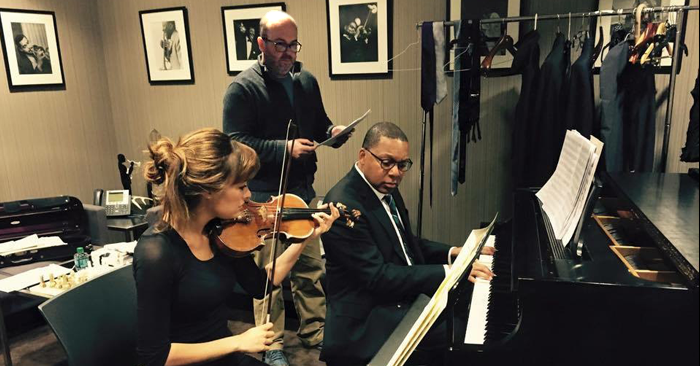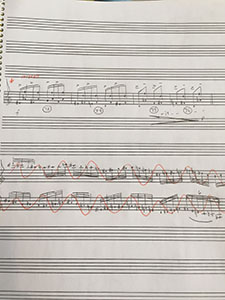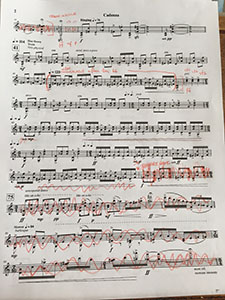
Photo of Nicola Benedetti, Jonathan Kelly, and Wynton Marsalis by Luigi Beverelli
Jonathan Kelly works as a music supervisor for Wynton Marsalis. In previous blog posts he explained how he got his enviable gig and shared some details of a collaboration between Wynton and the Garth Fagan Dance Company. Recently Jonathan and Wynton have been hard at work on a violin concerto, “Concerto in D,” in collaboration with Scottish violinist Nicola Benedetti. This project has been captured in a documentary film titled “Nicky and Wynton: The Making of a Concerto” by producer/director Chris Eley.
Upon seeing the trailer I was totally intrigued and reached out to Jonathan to catch up.
Can you describe your work with Wynton today? Has your role continued to evolve over the years?
Well my main role with Wynton is as a copyist. We’ve worked together now since 1999, so it’s also part mind reader. Ha.
I suppose in terms of evolution, I work much more closely with collaborators today than I would have when I started. For instance, with “Concerto in D,” I worked a lot with Nicola Benedetti for whom the concerto is written. The piece has been played with 5 or 6 orchestras at this point and when Wynton has had schedule conflicts, I’ve traveled with Nicky and done my best to fill Wynton’s role at rehearsals.
When did you first learn about the concerto?
To be honest with you, I can’t remember. Wynton’s so prolific that as a way to remain sane, I tend to only think about the project at hand. It may have been mentioned to me a few years ago, but I wasn’t really aware of it until Nicky started reaching out to me and seeing if we were working on it yet!
Was Ms. Benedetti involved from the start?
She’s been absolutely integral to the whole piece. From advocating for it with orchestras, to helping with the form, to being the absolute best critic of the piece, she’s been irreplaceable.
Can you describe your collaborative workflow on this particular project?
Since Nicky was so involved, we worked on this in a pretty unorthodox manner. We wrote the entirety of her part first, improved it with her input, and then orchestrated after her part was pretty much set.
As we’ve talked about before, Wynton still works in pencil and he’s almost always on the move, whether it be with the Jazz at Lincoln Center Orchestra or education initiatives, etc. Wherever he is, he’ll write some music and then send me texts with the pictures.
It beats the old days when he used to call me at three o’clock in the morning to have me come down to his apartment and pick up his manuscripts!
So much of this collaboration done long-distance?
It’s almost entirely done long-distance. For this piece, a filmmaker for the BBC named Chris Eley was filming a documentary and communication and travel really became a vital story line for the piece. Nicky’s in London, I’m in France and Wynton’s in New York. Or, I’m in New York, Wynton’s in Abu Dhabi and Nicky’s in Germany. It was pretty challenging time-zone-wise. But time zones don’t mean quite so much when you don’t sleep!
After Wynton’s hand-written sketches, how much of this work is done in Finale?
It’s all done in Finale once he gives me his pencil score. I’ll put everything into a full score format and from that point forward he’ll make any necessary pencil edits direct to a Finale produced score.
Inevitably during a piece like this, we fall behind schedule and an exasperated Wynton will call me and say, “Damn, I can’t possibly work any faster. How can we do this faster?” And I reply, “You gotta learn Finale, Papa.” He might be too old for new tricks, but I haven’t given up hope.
Do you ever revert back to an earlier versions for creative reasons?
For sure. For instance, with Nicky’s cadenza in the middle of the piece, I literally have over 50 versions saved. She would play through it and then want to go back to some earlier content. She’s not to blame for this; it’s really just Wynton’s process. If you go to Wynton and say, “Hey, I think bars 35-36 need some work,” he will re-write bars 25-57. It’s just the way he is. He’s an absolute machine of melodic material.
How does the project differ from other projects you’ve done together?
Nicky’s involvement is really what made this project so unique. I’ve done a bunch of collaborations, and they can be really challenging. Everybody’s workflow is so different and things can fall apart pretty quickly, especially with such big personalities.
When I met Nicky we clicked like old friends. I knew it would be better, but it’s still fraught with difficulties. So, I said to her, “Hey, let’s try and be friends when this is all over.” I don’t think she really knew what I meant, but she understood by the time the piece premiered in London!
It’s so many hours of work, it’s joy, it’s disappointment, it’s stress and it doesn’t exist in a vacuum; none of us have the type of careers that we can just go into the mountains for three months and come out with a piece. I mean, can you imagine the faith and courage it takes for a rising star violinist to enlist some of the greatest orchestras in the world and convince them to commission a piece that they will have to play whether they like it or not?! I can’t even imagine it.
Are you typically at the performances of the concerto?
I’m rarely at concerts because by the time one piece premieres, I’m usually knee deep in the next piece, but this one was bit different. Wynton actually couldn’t be at the world premiere of the piece in London because of a scheduling conflict, so I went in his stead.
The show went great and there’s a lot of high fives and hugs going on backstage. I wrote to Wynton and said, “It was great.” By the time things calmed down and I looked back at my phone I had dozens of texts from Wynton and a handful of missed calls. If I remember correctly, the last text from him read something like, “Well, Mr. Kelly, thanks for your thoughtful analysis of my piece!”
The trailer for the film is wonderful. I love Wynton’s quote at the end: “I love jazz music. And I love the orchestra. Now I think the two can come together; I may not be able to do it, but somebody can do it.” Can you talk about your aspect of this challenge?
I’ve now worked on 5 or 6 long form pieces for symphony orchestra that incorporate American styles of music including jazz and blues. I still haven’t conquered the challenge that he is alluding to in the clip.
Early in my career, I felt it was best to leave a lot of freedom in the interpretation to the musician. Then, I pulled a complete 180 and felt the need to articulate EVERYTHING and be very specific with instructions. Now, I’m starting to wonder; we never have enough rehearsal time and maybe that extra ink is actually more prohibitive than helpful. I’m not really clear on the best way to notate idiomatic things yet. If anyone has any good ideas, I’m all ears.
It’s certainly different in a workshop or school setting where you actually have time to talk to the musicians; but with the concerto, we are lucky to get 90 minutes of rehearsal time for a 45-minute piece that the musicians have never heard. It’s really challenging. Every minute you waste in rehearsal because of a lack of clarity in the notation, is a minute could be spent digging deeper and really finding the intention of the music.
How can folks in the US see the film?
Folks can watch the documentary on YouTube here.
Chris did a great job of capturing the difficulties that emerge with writing new music. And I’m not just saying this because I play the role of the court jester throughout the film!
Have any Finale tips? Things you like about Finale? Things you’d change?
In terms of tips, the best thing to do is follow this blog. No matter how long you have used the program, there is always some better, more efficient way to do things. In your interview with Hamilton orchestrator Alex Lacamoire, for instance, he talked about copying expressions to a nearby stave by clicking the handle, and pressing up or down while holding the Option key. Game Changer! It would be great if you could do that with hairpin crescendos, or some of the other measure-attached smart shapes as well.
If I had to add my own tip, it would be for musicians using chord symbols. Once you’ve created a palate of suffixes that you like, save the library. Then, if you work with someone else who doesn’t have your flair for visually stunning chords suffixes, you can just load your own library, delete theirs, and replace them with your own.
I also think it would be great if when working in a full score that is really tight, that you could highlight a page and then the program would increase/decrease the space between the staves so that there were no collisions.
But really, I can’t complain. I’ve said this before to you and I’ll stand by it. The work we do would quite literally not be possible without Finale. In fact, sometimes our workflow is so fast and accurate that I worry that we’ve set a pace that we won’t be able to maintain!
What’s next for you?
You know me, man—on to the next one. Wynton Marsalis, Jazz at Lincoln Center Orchestra and the New York Philharmonic premiering a new piece on December 28th at David Geffen Hall in New York City. Hopefully, they will have the music they need to play the concert!
I better get back to work!
Thanks to Jonathan, again, for taking the time to share his experiences with us. Please share your experiences with us via Facebook and Twitter.

